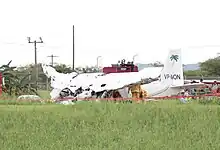 VP-MON, the Islander involved, photographed four months before the crash | |
| Accident | |
|---|---|
| Date | 7 October 2012 |
| Summary | Engine failure at take-off caused by rain that led fuel contamination and subsequent loss of control |
| Site | V. C. Bird International Airport, Antigua 17°08′00″N 61°47′47″W / 17.1333°N 61.7964°W |
| Aircraft | |
| Aircraft type | Britten-Norman Islander |
| Operator | FlyMontserrat |
| Registration | VP-MON |
| Flight origin | V. C. Bird International Airport, Antigua |
| Destination | John A. Osborne Airport, Montserrat |
| Occupants | 4 |
| Passengers | 3 |
| Crew | 1 |
| Fatalities | 3 |
| Injuries | 1 |
| Survivors | 1 |
FlyMontserrat Flight 107 was a short-haul flight from V. C. Bird International Airport, Antigua to John A. Osborne Airport, Montserrat. On 7 October 2012, the Britten-Norman Islander twin-engine aircraft serving the route crashed shortly after take off, near the end of the runway. Three of the four occupants were killed.[1]
Accident

At 16:15 local time FlyMontserrat Flight 107 was cleared for take off from runway 07 at V. C. Bird International Airport. Shortly after the Islander took off it started to yaw to the right and stopped climbing. The aircraft continued rolling to the right and lost height; it hit the ground and cartwheeled before coming to rest and bursting into flames. The pilot and one passenger were killed on impact, another passenger succumbed to her injuries before she could be extricated from the wreckage while the final passenger was seriously injured and taken to hospital.[2]
Investigation
The Eastern Caribbean Civil Aviation Authority (ECCAA) is responsible for regulation and oversight of aviation in Antigua, where the accident occurred.[3] Montserrat does not have its own investigators. As a British Overseas Territory this function is normally performed by the British Air Accidents Investigation Branch (AAIB), which sent a team to investigate the cause of the crash.[3] Bad weather conditions were reported for the time prior to the accident, however conditions were reported as good at the time of takeoff.
A preliminary report by the ECCAA was released in October 2012 saying that after examining the wreckage of the aircraft, it showed that the right engine was not producing power and the propeller was not feathered. The fuel was examined and found that the fuel system showed contamination with significant quantities of water.[4]
In July 2013, the AAIB released preliminary results of the investigation, setting out changes to prevent water contamination of Islander fuel systems; and an Airworthiness Directive was issued by the European Aviation Safety Agency (EASA) to require a check of Islanders to determine if the correct fuel filler caps had been installed. The AAIB recommended that EASA should require Britten-Norman Islander aircraft be equipped with fuel filter assemblies that minimise the likelihood of water in the fuel being fed to the engines.[5][6]
Final report
On 16 October 2015 the Air Accidents Investigation Branch (AAIB) on behalf of Eastern Caribbean Civil Aviation Authority (ECCAA) released the final report in which they said that the problable causes were the following:
- The presence of a significant rainfall, and the anomalies in the fuel filler neck and cap of the airplane, that are led to the presence of the water inside the right fuel tank.
- Soon after the takeoff, the water present in the fuel tank entered inside the fuel sistem of engines causing the engine to suddenly stop.
- The crew was no longer able to maintain control of the plane after the right engine stopped.
Other contributory factors are found by the investigation that are the following:
- A pre-flight water drain check was not carried out, this type of check have prevented the water to enter in the right engine fuel tank allowing the detection of the same(water) and would have also allowed the pilots to take the necessary corrective actions.
- It is possible that a performance-reducing windshear was encountered during the downwind departure that was a contribution to a reduction in airspeed soon before that the aircraft was in a stalled condition.[1]
See also
References
- 1 2 "Crash: Montserrat BN2P at Antigua on Oct 7th 2012, lost height after takeoff, contaminated fuel". Avherald.com. Retrieved 30 November 2012.
- ↑ Accident Report 7AC/1/99 (PDF). Eastern Caribbean Civil Aviation Authority. 15 October 2015. p. 7. Retrieved 15 January 2019.
- 1 2 Hewlett, LK. "UK Air Accidents Bureau Joins Investigation into Fly Montserrat Crash". The St. Kitts-Nevis Observer. Archived from the original on 5 March 2014. Retrieved 14 October 2012.
- ↑ Eastern Caribbean Civil Aviation Authority, ECCAA. "Interim Report Released on Cause of Fly Montserrat Crash: Water In Fuel Feeding System". MNI Alive. Archived from the original on 5 March 2014. Retrieved 14 October 2012. ()
- ↑ "Britten-Norman BN2A-26 Islander, VP-MON" (PDF). AAIB. Archived from the original (PDF) on 14 July 2013. Retrieved 4 July 2013. ()
- ↑ "AAIB recommends BN-2A Islander changes to prevent water contamination of fuel system". ASN. Retrieved 4 July 2013.